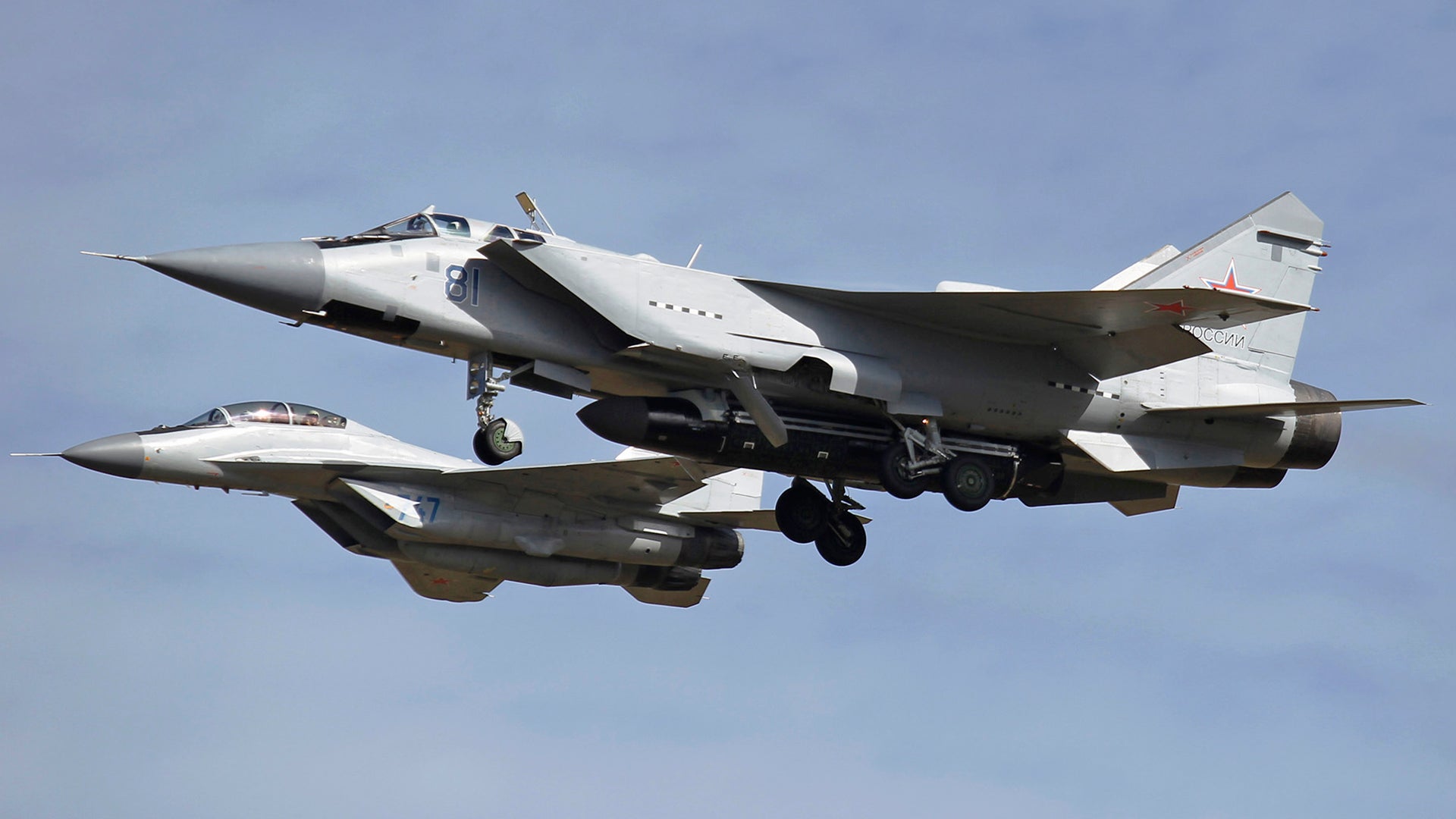Russia’s recent adaptation of their Iskander tactical ballistic missile into an air-launched weapon made major headlines and was among the least technologically reaching of Putin’s new cadre of superweapons that are supposedly in development. The carrier aircraft for that weapon, named ‘Kinzhal,’ is MiG-31 Foxhound interceptor. The MiG-31, which evolved out of the MiG-25 Foxbat, has the ability to carry heavy loads to high altitudes and at very speeds approaching mach three. This makes it an ideal launch platform not just for ballistic missiles meant to strike targets on the surface of the earth, but also for small suborbital or even orbital payloads, and especially direct-ascent anti-satellite weapons. On September 14th, 2018 what appears to be just such a launch system was photographed at Zhukovsky Airport outside of Moscow by aviation photographer ShipSash.
Zhukovsky is a major testing base for Russian aerial weaponry, something very loosely akin to Edwards Air Force Base here in the United States, although Zhukovsky now has a small commercial terminal as well. At the heart of the airport is a huge runway measuring nearly 18,000-foot long runway, the second largest publically accessible runway in the world. That long runway is there because the storied Gromov Flight Institute is also based at the airfield.
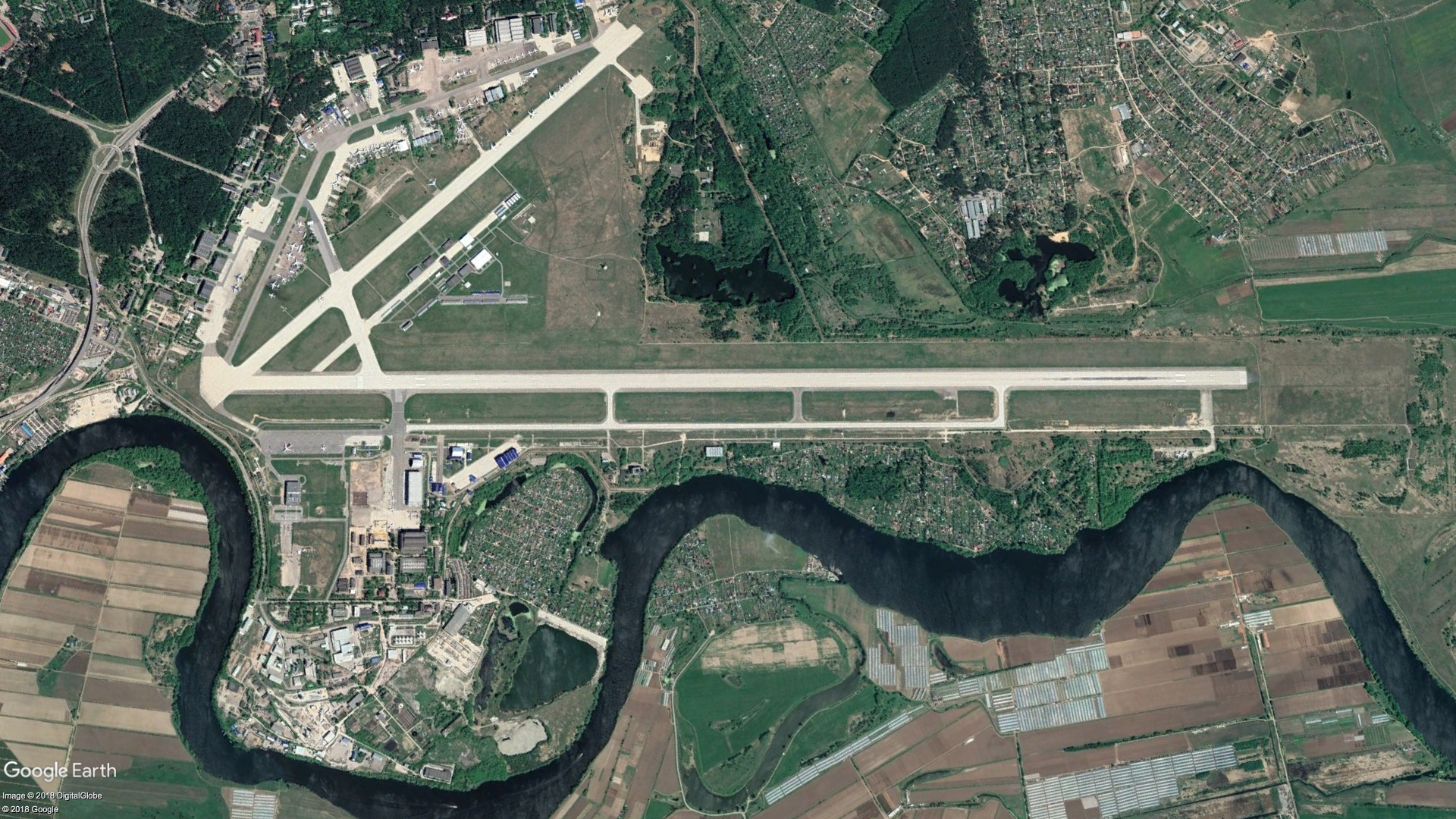
The institute operates a wide variety of aircraft for testing purposes, from Tu-154 transports to MiG-29s. One of these aircraft is a unique variant of the MiG-31, the same as is seen carrying this large missile aloft in the photo at the top of this article with the ’81 Blue’ bort number painted on its side. This particular aircraft started to appear in photos about a year ago. Initially, it seemed like a regular MiG-31BM, which is the designation assigned to the MiG-31s which have been progressively upgraded and modernized by the Russian air force. The MiG-31BM is easily distinguished by the periscope fairing on the cockpit canopy, as well as a large blade aerial on the bottom port side of the fuselage, close to the nose gear. It also features low profile missile pylons on the wings, which are meant to carry R-73 and R-77 missiles, replacing the wing mounted R-40 missile that older MiG-31 versions used to carry.
However, 81 Blue soon became a mystery since it had certain external features not present on standard MiG-31BMs. It lacked missile pylons completely and didn’t feature the large blade aerial. It did, however, have the periscope fairing, which suggests it went through a modernization similar to standard MiG-31BMs. It also featured two chin mounted blade shaped pitot tubes under the nose. Although there are some speculations, the purpose of the aircraft remained unknown.

After president Putin unveiling the new Kh-47B Kinzhal ballistic missile carried by the MiG-31 last March, a new version of the MiG-31 used to fire the Kinzhal, first dubbed MiG-31K by the media and later MiG-31BP by the Russian Ministry of Defense, was identified. It had all the same external features as the previously seen 81 Blue except the two chin mounted pitot tubes. This suggested that 81 Blue was still involved with a different program but one similar to Kinzhal.
In addition, all the MiG-31BPs are based at Akhtoobinsk, which is a remote flight test airbase in southern Russia, while 81 Blue is based at Zhukovsky, near Moscow. Throughout 2018, as more pictures of the MiG-31BP surfaced, it became clear that all of them were in the same external configuration and all of them featured air-to-air refueling probes.
About 500 MiG-31s were produced until the early 1990s, of which 349 were the basic version. Later, the MiG-31DZ introduced air-to-air refueling capability. The last and most capable version before production stopped in the early 1990s was the MiG-31B. It also featured a refueling probe. When the MiG-31BM modernization program first started, the Russian air force first upgraded its MiG-31Bs. Once they were all upgraded, older versions of the MiG-31 without air-to-air refueling started going through the modernization program. Oddly, the air-to-air refueling capable MiG-31DZs seemed to be skipped over. However, once the MiG-31BP came to light, all of them had refueling probes. Clearly, the MiG-31DZs had been routed towards the Kinzhal firing MiG-31BP program.

The photos of 81 Blue show it has a refueling probe, meaning it probably was upgraded from a MiG-31DZ and has a similar purpose as the MiG-31BP. In addition, a second aircraft similar to 81 Blue but carrying an ID ’06 Red’ was also spotted at Zhukovsky around the same time. It had all the same external features as 81 Blue, but lacked the periscope fairing. However, this might be a trivial detail.
A photo of 06 Red shows a round convex antenna on the top side of the left intake with an AS-77 antenna of the PPA-S/V-04 space and long-range navigation system. The directional A-737 antenna used by the GLONASS system, characteristic of upgraded MiG-31BMs, is retained. The convex antenna is also present on 81 Blue. So there may be two examples of this unique Foxhound variant intended for the same project.
According to unofficial information, the Mikoyan OKB has been working on two versions of the MiG-31 known internally as ‘article 06’ and ‘article 08.’ Article 08 was supposedly the carrier of the already known Kinzhal missile, with article 06 being a new version of the interceptor, with a completely different purpose—like potentially carrying an anti-satellite weapon or space launch system. It would feature a new inertial navigation system, radar, electronic warfare suite, and the suspension points under the fuselage have been reworked with the expectation of the weight of the new rocket.
This would not be the first time the MiG-31 has been used in an anti-satellite project. More than 30 years ago, in January 1987, the MiG-31D (“article 07”), which was the carrier of the 79M6 anti-satellite missile, made its first flight. The aircraft and missiles were elements of the anti-satellite weapon 30P6 ‘Kontakt’ system. The rocket was developed by KB Vympel. The project was largely a response to the United States’ own direct ascent air-launched anti-satellite missile system, the ASM-135, that used a modified F-15 called the Celestial Eagle as a launch platform. The weapon was successfully tested in 1985.

Two MiG-31D prototypes were made, however in 1991, work on the MiG-31D and its improved version the MiG-31DM with a 95M6 rocket (upgraded version 79M6) was stopped. After the collapse of the USSR, both prototypes of the MiG-31D remained at the Sary-Shagan test site in Kazakhstan—the same place where they were tested.
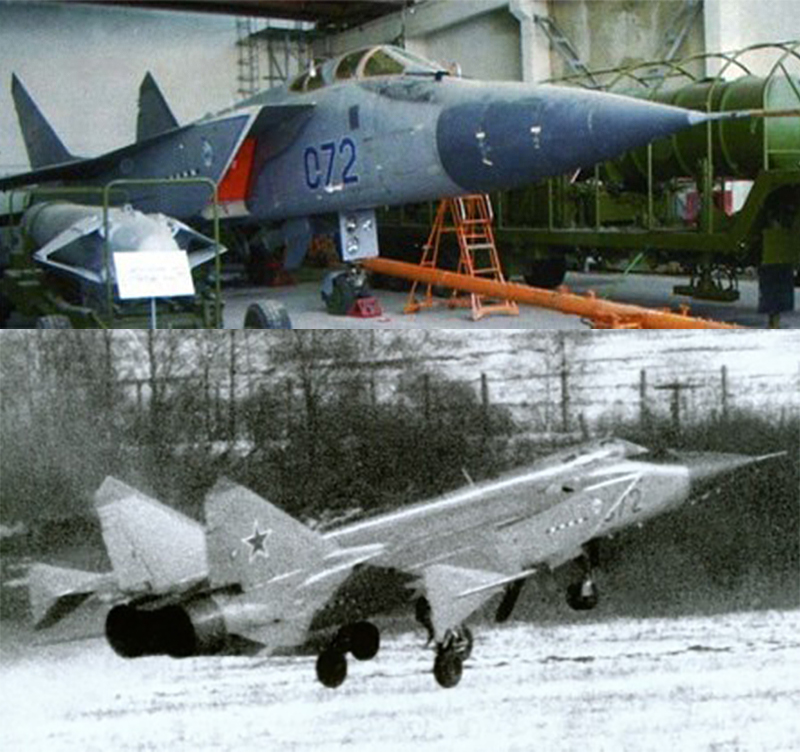
The MiG-31D differed from the base Foxhound, first of all, in the fact that it removed all the old weapons, parts of its avionics equipment, and eliminated the fuselage mounting points for the R-33 missiles. Vertical “winglets” were installed on the wingtips to increase stability when the anti-satellite rocket was suspended. Its radar was removed and a metal fairing replaced its radome. The whole idea was to fly as high and fast as possible to get the heavy anti-satellite missile in position to fire.
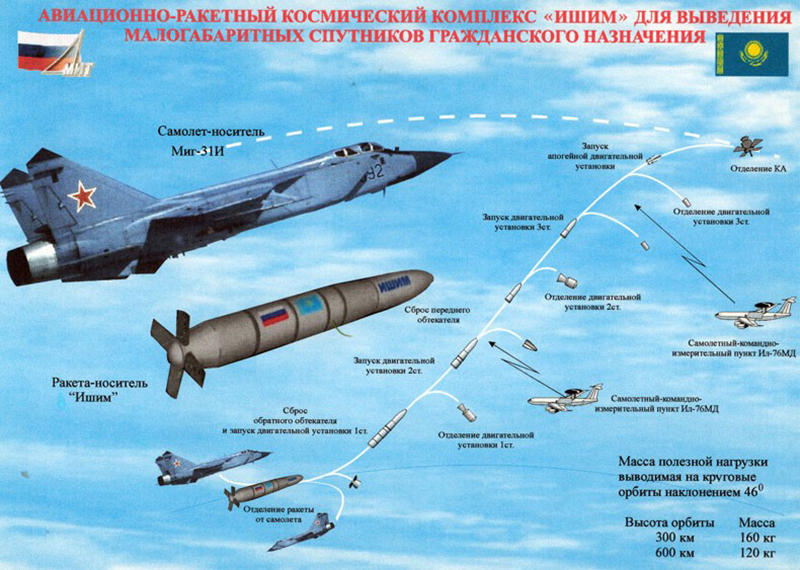
In 1997, MAPO MiG, leveraging their experience working on the MiG-31D, began the development of the MiG-31S. This aircraft was designed to launch rockets carrying small satellites into space. The rocket, named RN-S (“carrier rocket launched from aircraft”), with a capacity of up to 440lbs was planned to be launched from the aircraft flying at an altitude of about 51,000 at a speed of 1,865mph (Mach 2.8). The rocket was developed by the Vimpel design bureau.
The first launch was scheduled for 1999-2000 but it never happened. In 2001 RSK MiG tried to re-launch the design of the MiG-31S aircraft as a civil project for launching small satellites with a mass of 220lbs or less. This project didn’t evolve into an operational state either and there were other similar initiatives involving the MiG-31 that failed as well.
With all this in mind, the idea that Russia would be recycling old Soviet-era concepts to rapidly gain the ability to deploy small payloads into orbit via an air-launched rocket, or even more likely, take down enemy satellites in orbit—or possibly both—is glaringly logical.
The U.S. military and private industry have examined similar micro-satellite launch concepts, usually leveraging the F-15C Eagle as a launch platform. Today, multiple companies are working on using aircraft as first-stages for orbital access systems used to put a wide variety of payloads into various orbits, the heaviest-lifting being Stratolaunch with its Roc launcher aircraft.

Anti-satellite weaponry is a different story, as the U.S. seems to have moved its focus from direct-ascent kinetic kill concepts to less invasive ones that do not risk turning large stretches of low-earth orbit into a cloud of super-destructive debris, among many other advantages as well. These concepts include putting satellites into orbit that can jam, blind, disable, or even kill enemy satellites. You can read all about them here. By all indications, Russia is also working on similar concepts and likely has experimental capabilities along these lines already orbit.
These satellites are part of Russia’s larger and layered anti-satellite strategy that includes the development of an airborne laser intended to disable or destroy satellites (another recycled program from the Cold War era) and its emerging missile defense system also is thought to have distinct anti-satellite capabilities. China is moving along a similar path as Russia in developing an array of anti-satellite technologies.
Having a tactical asset like the MiG-31 that is able to take down satellites by surprise from pretty much any location that Russia has access to doesn’t just seem possible, it seems probable. It would make up a critically important tier of Russia’s layered anti-satellite weapons ‘complex.’ And since Russia has already spent decades developing similar air-launched systems, that research can be leveraged to rapidly get such a capability into an operational form.
The missile seen in the photograph is significantly larger than Kinzhal and appears to feature a set of folding fins at its rear. It is likely a two-stage system, or at least features a powered kill vehicle for anti-satellite duties.
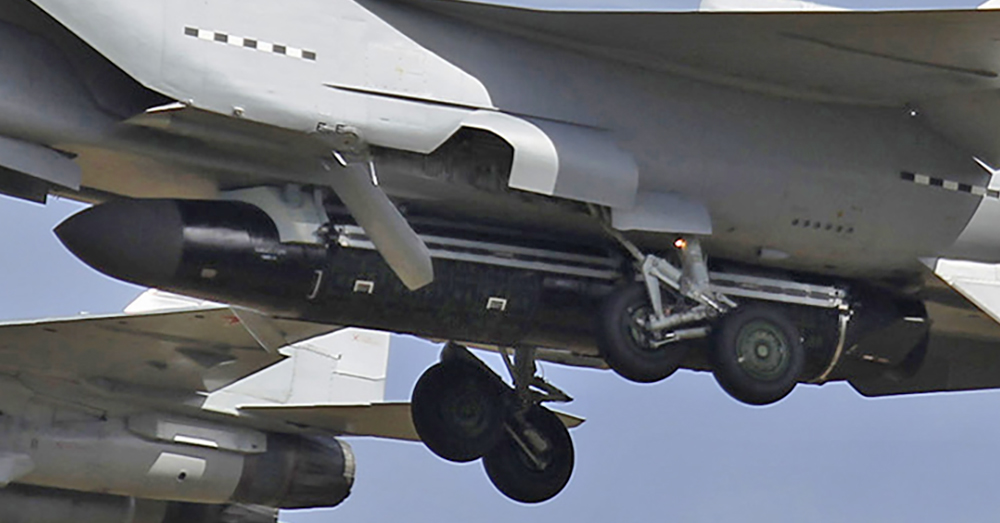
It’s also possible that this is another air-launched ballistic missile like Kinzhal, but that seems doubtful as Kinzhal is still very new itself and adding a bit more range to an already forward deployable system would have questionable value. Also, the profile of this weapon looks more like a space-launch asset than anything else.
There is also the possibility that this system is an anti-ship ballistic missile, which have major tactical and strategic merits. China is developing an air-launched version of its own DF-21D as part of its grand anti-access strategy aimed at keeping the U.S. Navy’s carrier strike groups at bay. But Kinzhal is already supposed to either have that capability or it is slated to acquire it sometime in the future. Developing a completely separate weapon for that role alone seems wasteful when an existing system can be adapted for it.
The latest video showing a Kinzhal air-launched ballistic missile test:

Another possibility is that this system is used to deploy an air-launched hypersonic boost-glide vehicle. But that speculation comes from an established interest in such a capability, not from any evidence in the photo, aside from maybe the thickness of the nose cone area.
We can’t stress enough, that above all else, being able to swat-down force multiplying American satellites in low-earth orbit with the inherent flexibility and surprise of an aerial launch platform would be very valuable to Russian forces, regardless of the consequences to the future habitability of low-earth orbit. On the other hand, being able to rapidly and unpredictably put up small satellites, especially to replace ones that are lost in battle, is also become increasingly important due to the growing proliferation of anti-satellite weaponry. It’s even possible that one system could be adapted for both roles. This could be just such a system.
We will report back to you as soon as we find out more about this mysterious missile and the Foxhound that carries it.
Update: October 8th, 2018—
A third aircraft, with tactical code 94 Red and the same distinguishing features as 81 Blue and 06 Red, has also been noted at Zhukovsky in May 2018. So at least three examples of this modification are known to exist.
Tyler’s note: This is the first time that talented photographer and aerospace journalist Ivan Voukadinov worked directly with me in developing and writing a story, but he has assisted me in the background on some very high-profile articles that I have posted here and on my previous two sites in the past. He is unbelievably knowledgeable about Russian aviation subjects. Hopefully, we will see more of him here in the future, but before then here’s a little more about Ivan:
“I live in Chicago but I’m originally from Bulgaria. I’ve been doing aviation journalism and photography for about a decade now. I’m interested in all aviation but I tend to focus more on Russian and Eastern Bloc aviation topics, both current and historical.”
Also, I want to give a huge thanks to ShipSash for sharing his photo with us. You can see more of his awesome shots here.
*Fixed the caption under the launch graphic to state that it was showing the MiG-31 small satellite launch concept.
Contact the author: Tyler@thedrive.com
